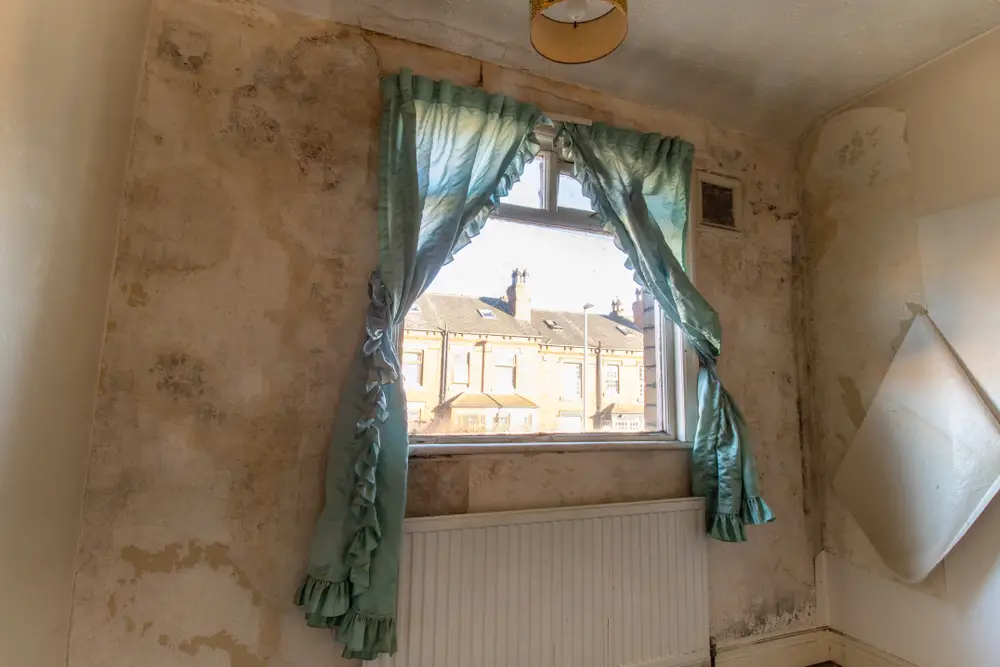Discovering a damp environment in your home is unwelcome, as it’s challenging to eliminate and can harm your health. Mold, if present, can quickly escalate and dominate your walls. If you’re noticing mold signs or concerned about its emergence, understanding its causes and prevention methods is crucial. Fortunately, there are steps you can take to minimize dampness in your home and prevent mold growth.

What Causes Dampness in Bedrooms?
Several factors can contribute to dampness inside your home, increasing the likelihood of mold development. Let’s explore some of these causes below.
Condensation
One of the most common causes of dampness in any home is condensation, but it mostly occurs in bedrooms, bathrooms, and kitchens.
This will happen when the moist air comes into contact with cold surfaces, which causes water to be deposited on the surface. This creates the ideal environment for mold to grow.
Too Much Moisture
Moisture can easily get into the air inside your home when you complete daily tasks, like cooking, cleaning, washing, and showering.
Moisture is something that often can’t be avoided, and through such activities, you can actually contribute to four pints of water in your home environment every day.
With modern advancements like double glazing and insulation, it can be really difficult for this mist air to exit your home, and this is when dampness can occur.
Poor Heating
As well as cold air, warm air is another contributor to moisture. So, the temperature of the air inside your home and any impermeable surfaces will increase the amount of condensation inside your home.
If you live in a house that is under heat, you may experience higher levels of condensation. As well as this, dramatic increases in temperature can also increase condensation levels. This is why it is so important to consistently heat your home to increase the average surface temperature.
Poor Ventilation
If you do not have sufficient ventilation in your house, condensation and mold growth can occur more easily.
A good amount of air flow will allow warm air that contains moisture to escape from your home.
However, if there is insufficient air ventilation in your home, the warm air will deposit onto a cold surface, and lead to damp.
Does Putting the Heating On Help Damp?
Putting on the heating can work to prevent dampness in certain circumstances. However, just because your house is warm, does not mean that you will not get damp.
Adequate ventilation is still really important if you want to avoid dampness. Interestingly, there is one specific type of heating that will actively fight dampness, which is infrared.
Many people have turned to using infrared panels to heat, and these panels work through the use of safe radiation. This means that they are able to heat the fabric of the building, and the people inside it, directly. The heat will be stored in thermal mass, even when you turn off the heaters.
Infrared heating can help to dry out the walls if they have previously been affected by dampness, providing that there are no other underlying issues. They can work to ensure that the walls do not get cold enough for water to settle on them.
What Are the Signs of Dampness in a House?
Some of the most common signs that you have damp in your home are:
- A damp and musty smell
- Physical mold on the walls, floors, or ceilings
- Walls, floors or ceilings that feel cold or damp
- Dark patches on the walls or plaster
- Wallpaper that has started to peel back
- High levels of condensation on your windows
Will a Dehumidifier Dry Out Damp Walls?
A dehumidifier will help to discourage the growth of mold and get rid of dampness. A dehumidifier will work to remove the moisture from the air and collect the water when it has been condensed.
They will also then heat the air back up before they return it to the room. These units will run off electricity, and they can lower the levels of humidity in your home dramatically. You will need to empty the water reservoir inside the machine quite frequently, depending on the type of dehumidifier that you buy and the amount of moisture that it collects. They can also be plumbed so that they dispose of the water down the drain themselves, without you having to do anything. They are highly useful for getting rid of dampness.
